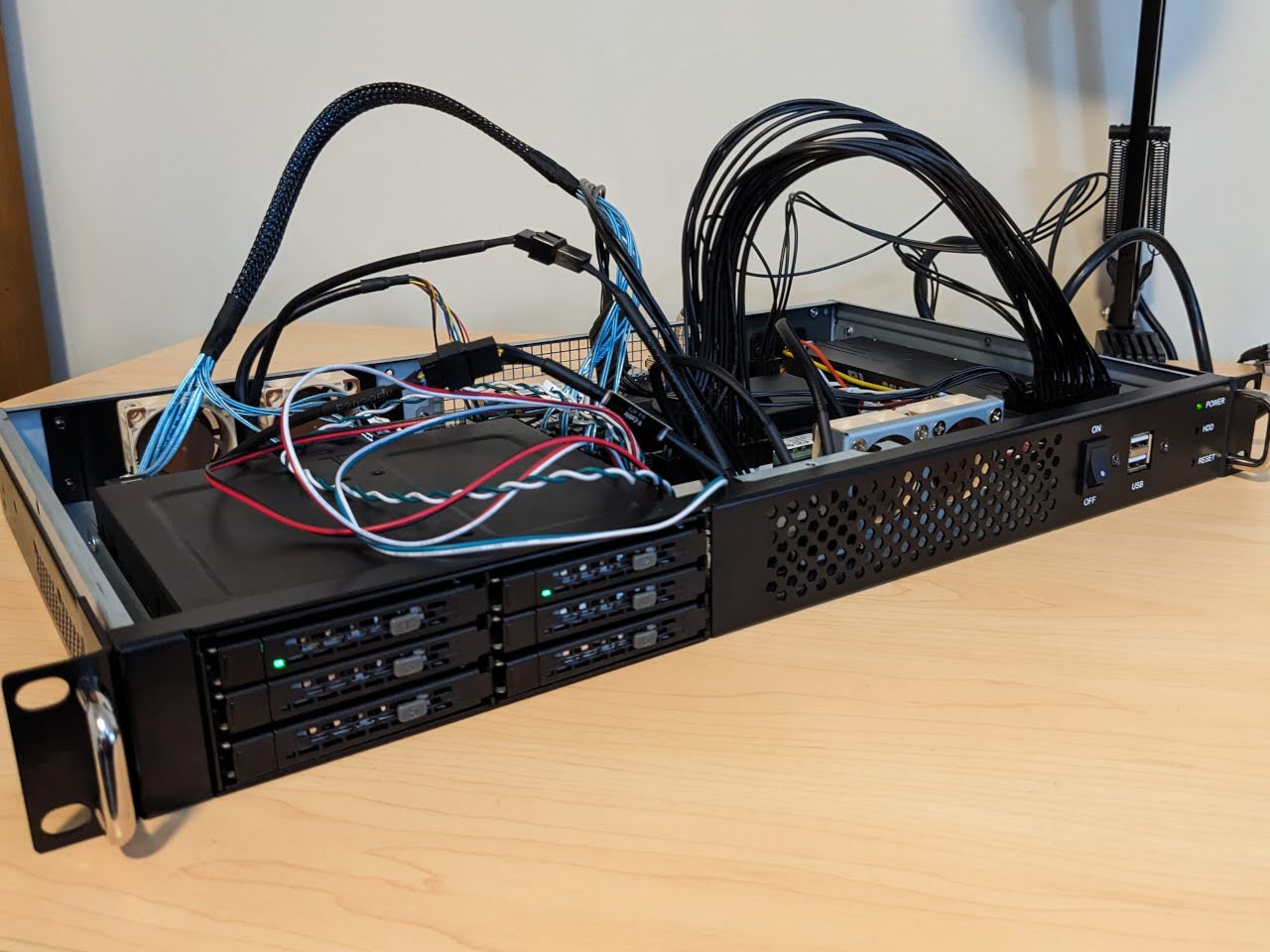In today’s fast-paced office environments, the constant hum of technology can be more than just an annoyance – it’s a significant barrier to productivity and focus. From whirring server fans to buzzing storage devices, traditional IT infrastructure often contributes to an increasingly noisy workspace that impacts employee well-being and performance. Enter the modern 4bay NAS (Network Attached Storage) solution, a game-changing approach that addresses both data management needs and workplace acoustics. These innovative systems deliver enterprise-grade storage capabilities while operating at whisper-quiet levels, proving that powerful performance doesn’t have to come at the cost of workplace tranquility. By implementing these sophisticated storage solutions, businesses can create a more comfortable working environment without compromising on data accessibility, security, or reliability. This guide explores how 4bay NAS systems are revolutionizing office environments by combining silent operation with robust storage capabilities, offering a practical path to a more productive and peaceful workplace.
The Silent Crisis: How Office Noise Impacts Business Productivity
Recent workplace studies have revealed the startling impact of noise pollution on business efficiency. Research from the University of California shows that office workers lose up to 86 minutes per day due to noise distractions, with traditional IT infrastructure being a significant contributor. Standard server rooms and storage systems typically generate noise levels between 50-70 decibels – equivalent to constant conversation or traffic noise. This persistent background noise has been directly linked to a 66% decrease in concentration and a 40% reduction in productivity among office employees. Employee satisfaction surveys indicate that 71% of workers cite equipment noise as a major source of workplace stress, affecting both their performance and job satisfaction. Modern 4-bay NAS solutions, operating at just 20-30 decibels, represent a dramatic improvement over conventional storage systems, offering noise levels comparable to a whispered conversation. This significant reduction in ambient noise creates an environment where employees can maintain focus and achieve optimal productivity.
Why 4bay NAS Systems Excel in Office Environments
4bay NAS systems represent the ideal balance between capacity and practicality for modern office environments. With support for up to four high-capacity drives, these systems typically provide 40-80TB of raw storage space – perfectly suited for small to medium business requirements without overprovisioning. The four-bay configuration enables sophisticated RAID implementations, particularly RAID 5 and RAID 6, offering the optimal compromise between data redundancy and usable storage space. Most organizations implement RAID 5, which provides excellent fault tolerance while maintaining approximately 75% of the total raw capacity for data storage. Beyond pure storage capabilities, modern 4-bay NAS units like UGREEN’s latest models pack enterprise-grade features into remarkably compact form factors. These systems support crucial business functions like automated backup scheduling, remote access protocols, and virtual machine hosting – all within a footprint smaller than a desktop computer. Use our raid calculator to determine the optimal RAID configuration for your storage needs. The streamlined design not only contributes to quieter operation but also allows for flexible placement options in space-constrained offices. Advanced features such as snapshot replication, encryption, and cloud integration ensure that these compact units deliver enterprise-level data protection without the complexity and noise associated with traditional server infrastructure.

Engineering Silence: How Modern NAS Achieves Quiet Operation
Advanced Heat Dissipation Techniques
Modern 4-bay NAS systems achieve near-silent operation through innovative thermal management approaches. Advanced passive cooling systems utilize strategically placed aluminum heat sinks with micro-fin arrays that maximize surface area for heat dissipation without requiring aggressive fan speeds. When active cooling is necessary, precision-engineered low-RPM fans incorporate fluid dynamic bearings that eliminate the typical whine associated with traditional ball-bearing designs. The chassis design features optimized airflow channels that direct heat away from critical components while minimizing turbulence-induced noise. Sophisticated temperature monitoring systems continuously adjust cooling parameters, preventing unnecessary fan speed increases and maintaining optimal acoustic levels.
Efficient Processing with 12th Gen Intel Pentium
The integration of 12th Generation Intel Pentium processors marks a significant advancement in NAS performance-to-noise ratios. These modern processors deliver exceptional performance while maintaining a thermal design power (TDP) that’s 40% lower than previous generations. The improved power efficiency translates directly to reduced heat output, enabling the cooling system to operate at lower, quieter speeds while maintaining optimal temperatures. Hardware-accelerated functions for common NAS operations, such as encryption and multimedia transcoding, complete tasks faster while generating less heat, further contributing to the system’s ability to maintain whisper-quiet operation even under heavy workloads.
Selecting Your Silent 4-bay NAS: Practical Buying Guide
When evaluating 4bay NAS solutions for noise-sensitive environments, start by examining the manufacturer’s stated decibel ratings under various workloads. Look for systems rated below 30dB during normal operation, which ensures conversation-level quietness. To accurately determine your storage needs, multiply your current data volume by 1.5 to account for near-term growth, then add 20% for system operations and snapshots. For optimal reliability, consider implementing RAID 5 with four identical drives – this configuration protects against single drive failure while maximizing usable storage space. For example, four 8TB drives in RAID 5 yield approximately 24TB of protected storage. When testing noise levels during evaluation, measure from multiple distances and angles, particularly at desk height from three feet away. Conduct measurements during various operations: idle, file transfers, and backup processes. Pay special attention to startup sounds and seek noise during drive access. Consider ambient office noise levels when setting acceptable thresholds – your NAS should ideally operate at least 10dB below typical office background noise. For comprehensive testing, monitor noise levels throughout a full backup cycle, as this represents maximum system stress. Document readings at different times of day to account for varying ambient conditions and system loads.
Implementation Blueprint: Setting Up Your Quiet NAS
Optimal Placement Strategies
Strategic NAS placement plays a crucial role in minimizing noise impact within office spaces. Position the unit at least three feet away from workstations, ideally in a corner or against a solid wall that can help absorb sound waves. Elevate the NAS using rubber or silicone feet to prevent vibration transfer through desk surfaces. Consider installing the unit in a well-ventilated cabinet with sound-dampening foam, ensuring adequate airflow is maintained. For open office layouts, create a dedicated equipment nook using acoustic panels or room dividers to further reduce noise transmission.
Configuration for Silent Efficiency
Begin quiet mode configuration by accessing the NAS management interface and enabling the built-in quiet operation profile under system settings. Adjust fan speed thresholds to favor silent operation, typically setting the trigger temperature 5-10 degrees higher than the default. Schedule intensive tasks like RAID synchronization and system backups during off-peak hours, preferably overnight between 11 PM and 5 AM. Configure the NAS to utilize “Smart Fan” or equivalent features that dynamically adjust cooling based on actual system load rather than fixed schedules. Implement drive spin-down policies for periods of inactivity, reducing both noise and power consumption. Set up email notifications to monitor temperature thresholds, ensuring the system maintains optimal performance while operating in quiet mode. Regular firmware updates often include improved fan control algorithms, so enable automatic updates during maintenance windows.
Beyond Silence: Additional Business Benefits
While noise reduction remains a primary advantage, modern 4-bay NAS solutions deliver additional critical benefits that strengthen business operations. These systems achieve remarkable uptime statistics, typically exceeding 99.9% availability through enterprise-grade components and redundant configurations. The latest models consume 40-60% less power compared to traditional server setups, translating to measurable cost savings on utility bills and reduced environmental impact. A single 4-bay NAS can effectively replace multiple legacy storage devices, decreasing both energy consumption and maintenance overhead. The modular nature of these systems enables seamless capacity expansion – businesses can start with smaller drives and upgrade as needed without disrupting operations. This scalability ensures protection of initial investments while accommodating future growth. Advanced firmware platforms support evolving business needs through regular feature updates, extending the solution’s lifespan and maximizing return on investment.
Transforming Workspaces Through Silent Storage Innovation
The challenge of office noise pollution, particularly from IT infrastructure, has long plagued workplace productivity and employee well-being. Modern 4-bay NAS solutions have emerged as a transformative answer to this persistent problem, offering an elegant balance between powerful storage capabilities and whisper-quiet operation. These systems prove that businesses no longer need to choose between robust data management and a peaceful work environment. By implementing a properly configured 4-bay NAS solution, organizations can significantly reduce ambient noise levels while gaining enterprise-grade storage features, improved data security, and enhanced operational efficiency. The time has come for businesses to evaluate their current storage infrastructure’s impact on workplace acoustics and consider the substantial benefits of transitioning to these quieter alternatives. As workplaces continue to evolve, the implementation of noise-conscious technology solutions like 4bay NAS systems will play an increasingly crucial role in creating productive, comfortable, and sustainable office environments that support both employee well-being and business success.


